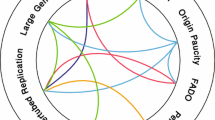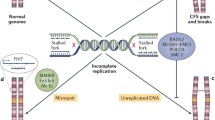Abstract
Conditions of replication stress affect expression of all common fragile regions, including FRA3B (chromosome 3p14.2), FRA16D (16q23), FRA6E (6q26), FRA7G (7q31.2), and FRAXB (Xp22.3), and a number of cancer cell lines exhibit homozygous deletions in 2 or more common fragile regions. In 1996 the fragile histidine triad (FHIT) gene was isolated from the region encompassing the most active fragile FRA3B locus, and recently the WW domain-containing oxidoreductase gene (WWOX) was identified at FRA16D.These 2 fragile genes are altered or deleted in various epithelial tumors and exhibit tumor suppressor function. Aberration or absence of WWOX expression recently was detected in primary hematopoietic malignancies. The aberration resulted not only from genomic deletions but also possibly from epigenetic modifications associated with expression of fragility. Thus chromosomal aberrations at common fragile sites, in addition to the well-defined hallmark leukemia chromosome translocations, are involved in clinicopathological outcomes of hematopoietic malignancies.
Similar content being viewed by others
References
Struski S, Doco-Fenzy M, Cornillet-Lefebvre P. Compilation of published comparative genomic hybridization studies. Cancer Genet Cytogenet. 2002;135:63–90.
Heerema NA. Chromosomes in lymphomas and solid tumors. Cancer Invest. 1998;16:183–187.
Druker BJ, O’Brien SG, Cortes J, Radich J. Chronic myelogenous leukemia. Hematology. 2002:111-135.
Clarkson B, Strife A, Wisniewski D, Lambek CL, Liu C. Chronic myelogenous leukemia as a paradigm of early cancer and possible curative strategies. Leukemia. 2003;17:1211–1262.
Croce CM. Role of TCL1 and ALL1 in human leukemias and development. Cancer Res. 1999;59(suppl 7):1778s-1783s.
Schichman SA, Canaani E, Croce CM. Self-fusion of the ALL1 gene: a new genetic mechanism for acute leukemia. JAMA. 1995;273:571–576.
Salomoni P, Pandolfi PP. The role of PML in tumor suppression. Cell. 2002;108:165–170.
Soussi T. The p53 tumour suppressor gene: a model for molecular epidemiology of human cancer. Mol Med Today. 1996;2:32–37.
Ruiz J, Mazzolini G, Sangro B, Qian C, Prieto J. Gene therapy of hepatocellular carcinoma. Dig Dis. 2001;19:324–332.
Baylin S, Bestor TH. Altered methylation patterns in cancer cell genomes: cause or consequence? Cancer Cell. 2002;1:299–305.
Tamura G. Genetic and epigenetic alterations of tumor suppressor and tumor-related genes in gastric cancer. Histol Histopathol. 2002;17:323–329.
Krug U, Ganser A, Koeffler HP. Tumor suppressor genes in normal and malignant hematopoiesis. Oncogene. 2002;21:3475–3495.
Liu Y, Ganesan TS. Tumour suppressor genes in sporadic epithelial ovarian cancer. Reproduction. 2002;123:341–353.
Cohen AJ, Li FP, Berg S, et al. Hereditary renal-cell carcinoma associated with a chromosomal translocation. N Engl J Med. 1979;301:592–595.
Huebner K, Croce CM. FRA3B and other common fragile sites: the weakest link. Nat Rev Cancer. 2001;1:214–221.
Siprashvili Z, Sozzi G, Barnes LD, et al. Replacement of Fhit in cancer cells suppresses tumorigenicity. Proc Natl Acad Sci U S A. 1997;94:13771–13776.
Ji L, Fang B, Yen N, Fong K, Minna JD, Roth JA. Induction of apoptosis and inhibition of tumorigenicity and tumor growth by adenovirus vector-mediated fragile histidine triad (FHIT) gene overexpression. Cancer Res. 1999;59:3333–3339.
Sard L, Accornero P, Tornielli S, et al. The tumor-suppressor gene FHIT is involved in the regulation of apoptosis and in cell cycle control. Proc Natl Acad Sci U S A. 1999;96:8489–8492.
Ishii H, Dumon KR, Vecchione A, et al. Potential cancer therapy with the fragile histidine triad gene: review of the preclinical studies. JAMA. 2001;286:2441–2449.
Bednarek AK, Keck-Waggoner CL, Daniel RL, et al. WWOX, the FRA16D gene, behaves as a suppressor of tumor growth. Cancer Res. 2001;61:8068–8073.
Kuroki T, Trapasso F, Shiraishi T, et al. Genetic alterations of the tumor suppressor gene WWOX in esophageal squamous cell carcinoma. Cancer Res. 2002;62:2258–2260.
Glover TW, Berger C, Coyle J, Echo B. DNA polymerase alpha inhibition by aphidicolin induces gaps and breaks at common fragile sites in human chromosomes. Hum Genet. 1984;67:136–142.
Yunis JJ, Soreng AL. Constitutive fragile sites and cancer. Science. 1984;226:1199–1204.
Arlt MF, Miller DE, Beer DG, Glover TW. Molecular characterization of FRAXB and comparative common fragile site instability in cancer cells. Gene Chromosomes Cancer. 2002;33:82–92.
Ohta M, Inoue H, Cotticelli MG, et al. The FHIT gene, spanning the chromosome 3p14.2 fragile site and renal carcinoma-associated t(3;8) breakpoint, is abnormal in digestive tract cancers. Cell. 1996;84:587–597.
Sozzi G, Huebner K, Croce CM. FHIT in human cancer. Adv Cancer Res. 1998;74:141–166.
Zochbauer-Muller S, Fong KM, Maitra A, et al. 5 CpG island methylation of the FHIT gene is correlated with loss of gene expression in lung and breast cancer. Cancer Res. 2001;61:3581–3585.
Tanaka H, Shimada Y, Harada H, et al. Methylation of the 5 CpG island of the FHIT gene is closely associated with transcriptional inactivation in esophageal squamous cell carcinomas. Cancer Res. 1998;58:3429–3434.
Trapasso F, Krakowiak A, Cesari R, et al. Designed FHIT alleles establish that Fhit-induced apoptosis in cancer cells is limited by substrate binding. Proc Natl Acad Sci U S A. 2003;100:1592–1597.
Bednarek AK, Laflin KJ, Daniel RL, Liao Q, Hawkins KA, Aldaz CM. WWOX, a novel WW domain-containing protein mapping to human chromosome 16q23.3-24.1, a region frequently affected in breast cancer. Cancer Res. 2000;60:2140–2145.
Paige AJ, Taylor KJ, Taylor C, et al. WWOX: a candidate tumor suppressor gene involved in multiple tumor types. Proc Natl Acad Sci U S A. 2001;98:11417–11422.
Richards RI. Fragile and unstable chromosomes in cancer: causes and consequences. Trends Genet. 2001;17:339–345.
Ludes-Meyers JH, Bednarek AK, Popescu NC, Bedford M, Aldaz CM. WWOX, the common chromosomal fragile site, FRA16D, cancer gene. Cytogenet Genome Res. 2003;100:101–110.
Yendamuri S, Kuroki T, Trapasso F, et al. WW domain containing oxidoreductase gene expression is altered in non-small cell lung cancer. Cancer Res. 2003;63:878–881.
Chang NS, Doherty J, Ensign A. JNK1 physically interacts with WW domain-containing oxidoreductase (WOX1) and inhibits WOX1-mediated apoptosis. J Biol Chem. 2003;278:9195–9202.
Lin PM, Liu TC, Chang JG, Chen TP, Lin SF. Aberrant FHIT transcripts in acute myeloid leukaemia. Br J Haematol. 1997;99:612–617.
Iwai T, Yokota S, Nakao M, et al. Frequent aberration of FHIT gene expression in acute leukemias. Cancer Res. 1998;58:5182–5187.
Wang L, Dong LJ, Tian F, Liu GX, Li CH. Aberrant expression and deletion of FHIT gene in leukemias. Zhongguo Shi Yan Xue Ye Xue Za Zhi. 2003;11:153–160.
Albitar M, Manshouri T, Gidel C, et al. Clinical significance of fragile histidine triad gene expression in adult acute lymphoblastic leukemia. Leuk Res. 2001;25:859–864.
Hallas C, Albitar M, Letofsky J, Keating MJ, Huebner K, Croce CM. Loss of FHIT expression in acute lymphoblastic leukemia. Clin Cancer Res. 1999;5:2409–2414.
Kantarjian HM, Talpaz M, O’Brien S, et al. Significance of FHIT expression in chronic myelogenous leukemia. Clin Cancer Res. 1999;5:4059–4064.
Ishii H, Vecchione A, Furukawa Y, et al. Expression of FRA16D/WWOX and FRA3B/FHIT genes in hematopoietic malignancies. Mol Cancer Res. 2003;1:940–947.
Carapeti M, Aguiar RC, Sill H, Goldman JM, Cross NC. Aberrant transcripts of the FHIT gene are expressed in normal and leukaemic haemopoietic cells. Br J Cancer. 1998;78:601–605.
Peters UR, Hasse U, Oppliger E, et al. Aberrant FHIT mRNA transcripts are present in malignant and normal haematopoiesis, but absence of FHIT protein is restricted to leukaemia. Oncogene. 1999;18:79–85.
Chang KW, Kao SY, Tzeng RJ, et al. Multiple molecular alterations of FHIT in betel-associated oral carcinoma. J Pathol. 2002;196:300–306.
Maruyama R, Toyooka S, Toyooka KO, et al. Aberrant promoter methylation profile of prostate cancers and its relationship to clinicopathological features. Clin Cancer Res. 2002;8:514–519.
Maruyama R, Toyooka S, Toyooka KO, et al. Aberrant promoter methylation profile of bladder cancer and its relationship to clinicopathological features. Cancer Res. 2001;61:8659–8663.
Inoue H, Ishii H, Alder H, et al. Sequence of the FRA3B common fragile region: implications for the mechanism of FHIT deletion. Proc Natl Acad Sci U S A. 1997;94:14584–14589.
Mimori K, Druck T, Inoue H, et al. Cancer-specific chromosome alterations in the constitutive fragile region FRA3B. Proc Natl Acad Sci U S A. 1999;96:7456–7461.
Corbin S, Neilly ME, Espinosa R 3rd, Davis EM, McKeithan TW, Le Beau MM. Identification of unstable sequences within the common fragile site at 3p14.2: implications for the mechanism of deletions within fragile histidine triad gene/common fragile site at 3p14.2 in tumors. Cancer Res. 2002;62:3477–3484.
Noguchi T, Takeno S, Kimura Y, et al. FHIT expression and hypermethylation in esophageal squamous cell carcinoma. Int J Mol Med. 2003;11:441–447.
Kuroki T, Trapasso F, Yendamuri S, et al. Allele loss and promoter hypermethylation of VHL, RAR-beta, RASSF1A, and FHIT tumor suppressor genes on chromosome 3p in esophageal squamous cell carcinoma. Cancer Res. 2003;63:3724–3728.
Yang Q, Nakamura M, Nakamura Y, et al. Two-hit inactivation of FHIT by loss of heterozygosity and hypermethylation in breast cancer. Clin Cancer Res. 2002;8:2890–2893.
Wu Q, Shi H, Suo Z, Nesland JM. 5-CpG island methylation of the FHIT gene is associated with reduced protein expression and higher clinical stage in cervical carcinomas. Ultrastruct Pathol. 2003;27:417–422.
Casper AM, Nghiem P, Arlt MF, Glover TW. ATR regulates fragile site stability. Cell. 2002;111:779–789.
Arlt MF, Casper AM, Glover TW. Common fragile sites. Cytogenet Genome Res. 2003;100:92–100.
Author information
Authors and Affiliations
About this article
Cite this article
Ishii, H., Furukawa, Y. Alterations of common chromosome fragile sites in hematopoietic malignancies. Int J Hematol 79, 238–242 (2004). https://doi.org/10.1532/IJH97.03145
Received:
Revised:
Accepted:
Published:
Issue Date:
DOI: https://doi.org/10.1532/IJH97.03145




